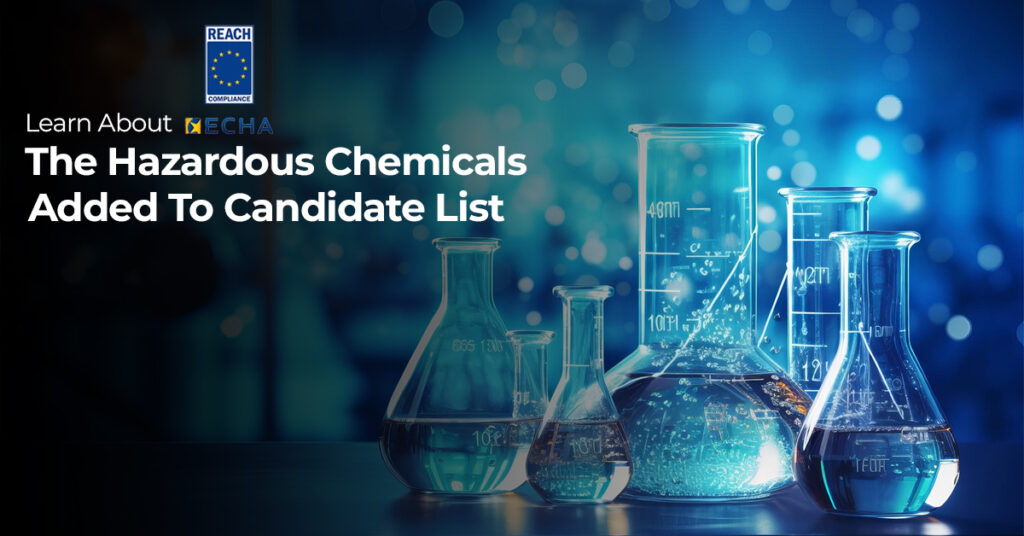
Staying informed about hazardous substances is crucial in the intricate landscape of chemical safety and environmental protection. One significant framework addressing this concern is the Candidate List, a compilation of chemicals that may pose severe risks to human health or the environment. This blog explains the recent additions to the Candidate List, shedding light on their potential hazards and the importance of monitoring and regulating these substances.
Understanding The Candidate List
The Candidate List is integral to the Registration, Evaluation, Authorization, and Restriction of Chemicals REACH Compliance in the European Union. This list is periodically updated with substances considered for inclusion in Annex XIV, also known as the Authorization List. Inclusion on the Candidate List signifies that a substance may be subject to authorization to phase out or restrict its use to minimize risks.
Entries Of Hazardous Substances In Candidate List
2,4,6-Tri-Tert-Butylphenol:
2,4,6-tri-tert-butylphenol is a chemical compound that has been added to the candidate list due to its toxicity for reproduction (Article 57c) and its classification as a Persistent, Bioaccumulative, and Toxic (PBT) substance under Article 57d. This compound is involved in manufacturing various other substances and formulating mixtures and fuel products, raising concerns about its potential environmental impact and adverse effects on reproductive health.
2-(2h-Benzotriazol-2-Yl)-4-(1,1,3,3-Tetramethylbutyl)Phenol:
2,4,6-tri-tert-butylphenol is a chemical compound added to the candidate list due to its classification as toxic for reproduction under Article 57c. Additionally, it exhibits characteristics of being very persistent and very bioaccumulative (vPvB) according to Article 57e. This substance is commonly found in coating products, air care products, adhesives, sealants, lubricants, greases, polishes, waxes, washing and various cleaning products, posing potential risks to human health and the environment.
2-(Dimethylamino)-2-[(4-Methylphenyl)Methyl]-1-[4-(Morpholin-4-Yl)Phenyl]Butan-1-One:
2,4,6-tri-tert-butylphenol, identified as toxic for reproduction under Article 57c, is a chemical compound added to the candidate list due to its adverse effects on reproductive health. This substance is commonly employed in inks, toners, and coating products, warranting careful consideration and regulatory attention within the context of potential reproductive toxicity concerns.
Bumetrizole:
2,4,6-tri-tert-butylphenol is a chemical compound in the candidate list due to its classification as toxic for reproduction under Article 57c of chemical regulations. Additionally, it meets the criteria for being a very persistent and very bioaccumulative substance (vPvB) according to Article 57e. This compound is commonly found in coating products, sealants, adhesives, cleaning, and washing products, raising concerns about its potential impact on reproductive health and the environment.
Oligomerization & Alkylation Reaction Products Of 2-Phenylpropene And Phenol:
2,4,6-tri-tert-butylphenol is a chemical compound included in the candidate list due to its toxicity for reproduction (Article 57c). Additionally, it has been identified as a very persistent and very bioaccumulative substance (vPvB, Article 57e). This compound is commonly found in adhesives, sealants, fillers, coating products, plasters, modeling clay, putties, inks, polymers, and toners, emphasizing careful consideration and regulatory attention in these product categories.
Dibutyl Phthalate (Recent Update):
2,4,6-tri-tert-butylphenol is a chemical compound in the candidate list due to its reproductive toxicity, falling under Article 57c. This substance has demonstrated adverse effects on reproductive health. Additionally, it possesses endocrine-disrupting properties, as specified in Article 57(f) related to environmental concerns. It is essential to monitor and regulate its use to mitigate potential environmental and health risks as it is found in various applications such as metal working fluids, washing and cleaning products, laboratory chemicals, and polymers,
The ECHA committee of State Members has affirmed the confirmation of the inclusion of these compounds in the Candidate List. Currently, the list encompasses 240 items, wherein specific entries represent chemical clusters, resulting in a greater total of affected substances.
Staying informed about hazardous chemicals added to the Candidate List is vital for individuals, industries, and policymakers. The ongoing effort to regulate and, if necessary, eliminate substances with potential risks to human health and the environment reflects a commitment to a safer and more sustainable future. As we continue to uncover the complexities of chemical safety, proactive measures and responsible practices, partner with Sunstream to abide by regulations such as ROHS, REACH, conflict mineral compliance, and SDS, guaranteeing that businesses are equipped with accurate and up-to-date information, enabling them to make informed decisions regarding the handling, storage, and disposal of chemicals.



 +1.585.935.7123
+1.585.935.7123 +91-804-148-6861
+91-804-148-6861